 Backend Development
Backend Development
 PHP Tutorial
PHP Tutorial
 Detailed explanation of usage examples of foreach array traversal in PHP array (picture)
Detailed explanation of usage examples of foreach array traversal in PHP array (picture)
Detailed explanation of usage examples of foreach array traversal in PHP array (picture)
What is foreach to traverse an array?
When we use foreach to traverse an array, we often make mistakes due to unclear concepts. Here is a brief introduction to commonly used foreach operations.
(PHP 4, PHP 5, PHP 7)
The foreach syntax structure provides a simple way to traverse an array. foreach can only be applied to arrays and objects. If you try to apply it to variables of other data types, or uninitialized variables, an error message will be issued.
Two syntaxes for each foreach to traverse an array:
foreach (array_expression as $value)
statement
foreach (array_expression as $key => $value)
statementThe first format traverses the given array_expression array. In each loop, the value of the current unit is assigned to $value and the pointer inside the array moves forward one step (so the next unit will be obtained in the next loop).
The second format does the same thing, except that the key name of the current unit will also be assigned to the variable $key in each loop.
Since PHP 5, it is also possible to traverse objects.
Note: When foreach starts executing, the pointer inside the array will automatically point to the first unit. This means there is no need to call reset() before the foreach loop.
Note: Unless the array is referenced, foreach operates on a copy of the specified array, not the array itself. foreach has some side effects on array pointers. Do not rely on the value of an array pointer during or after a foreach loop unless it is reset.
Since PHP 5, it is easy to modify the elements of an array by adding & before $value. This method assigns by reference rather than copying a value. The reference to
<?php
header("Content-Type:text/html; charset=utf-8");
$arr = array(1, 2, 3, 4);
foreach ($arr as &$value) {
$value = $value * 2;
}
// $arr is now array(2, 4, 6, 8)
unset($value); // 最后取消掉引用
?>$value is only available if the array being traversed can be referenced (for example, it is a variable). The following code will not run:
<?php
foreach (array(1, 2, 3, 4) as &$value) {
$value = $value * 2;
}
?>Note: The $value reference of the last element of the array will still be retained after the foreach loop. It is recommended to use unset() to destroy it. foreach does not support the ability to suppress error messages using "@".
The following is an example of php foreach traversing an array
1. The array to be traversed is a one-dimensional array, which is relatively simple. If it is a single array, it is expressed in two ways, as follows:
<?php
header("Content-Type:text/html; charset=utf-8");
$array = array("PHP中文网","百度","搜狗","www.php.cn");
foreach ($array as $value){
echo $value."<br>";
}
echo "<br>";
foreach ($array as $key =>$value){
echo $key."--".$value."<br>";
}
?>The output result is:
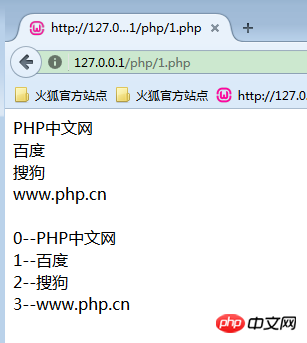
2. If it is a one-dimensional associative array, it is displayed as follows, Note that the key values are different:
<?php
header("Content-Type:text/html; charset=utf-8");
$array = array("网站1"=>"PHP中文网","网站2"=>"百度","网站3"=>"搜狗","网址"=>"www.php.cn");
foreach ($array as $value){
echo $value."<br>";
}
echo "<br>";
foreach ($array as $key =>$value){
echo $key."--".$value."<br>";
}
?>The traversal result is:
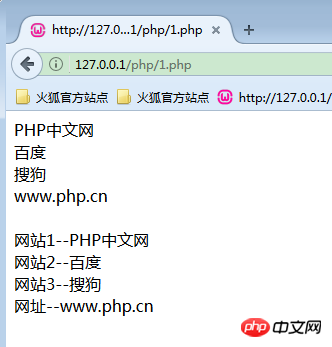
3. It is a little troublesome when traversing a two-dimensional array One point, the value at this time is an array, from which a variety of methods of operating arrays can be derived. Let’s traverse the basic two-dimensional array first:
<?php
header("Content-Type:text/html; charset=utf-8");
$array = array(
array("1","PHP中文网"),
array("2","www.php.cn"),
array("3","百度"),
array("4","搜狗")
);
foreach ($array as $value){
print_r($value);
echo "<br>";
}
?>The traversal results are as follows:
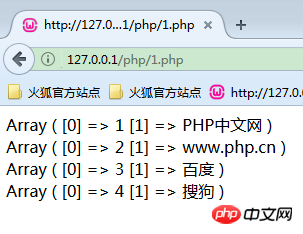
Use the second method. When traversing the array, pay attention to the key The value of , do not confuse it with the array id value;
<?php
header("Content-Type:text/html; charset=utf-8");
$array = array(
array("1","PHP中文网"),
array("2","www.php.cn"),
array("3","百度"),
array("4","搜狗")
);
foreach ($array as $key =>$value){
echo "key =".$key."<br>";
print_r($value);
echo "<br>";
}
?>The traversal results are as follows:
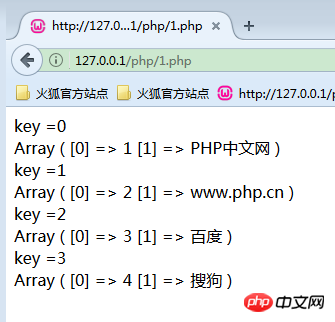
In addition, there are often requests to change a certain column of the two-dimensional array It becomes a one-dimensional array. At this time, the corresponding fields in value need to be taken out and placed in a one-dimensional array. If it is operated with a for loop, it is more cumbersome. It is simpler to use foreach. As follows, get the id column and name column of the current array. , stored in one-dimensional arrays respectively:
<?php
header("Content-Type:text/html; charset=utf-8");
$array = array(
array("id"=>"1","name"=>"PHP中文网"),
array("id"=>"2","name"=>"www.php.cn"),
array("id"=>"3","name"=>"百度"),
array("id"=>"4","name"=>"搜狗")
); //二维数组定义
//获取某一列作为一维数组
$idArr = array();//id列
$nameARR = array();//name列
foreach($array as $key => $value){
$arr = $value["id"];
$idArr =$arr; //存入ID列
$name = $value["name"];
$nameARR = $name; //存入name列
print_r($idArr);
print_r($nameARR);
}
?>The traversal result is:
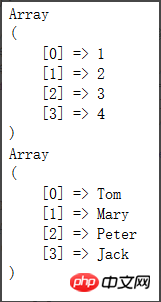
[Related tutorial recommendations]
1. Recommended related topics: "php array (Array)"
2. Recommended related video courses: " Use a foreach loop to traverse: index and associative array》
The above is the detailed content of Detailed explanation of usage examples of foreach array traversal in PHP array (picture). For more information, please follow other related articles on the PHP Chinese website!

Hot AI Tools

Undresser.AI Undress
AI-powered app for creating realistic nude photos

AI Clothes Remover
Online AI tool for removing clothes from photos.

Undress AI Tool
Undress images for free

Clothoff.io
AI clothes remover

Video Face Swap
Swap faces in any video effortlessly with our completely free AI face swap tool!

Hot Article

Hot Tools

Notepad++7.3.1
Easy-to-use and free code editor

SublimeText3 Chinese version
Chinese version, very easy to use

Zend Studio 13.0.1
Powerful PHP integrated development environment

Dreamweaver CS6
Visual web development tools

SublimeText3 Mac version
God-level code editing software (SublimeText3)

Hot Topics
 1386
1386
 52
52
 PHP 8.4 Installation and Upgrade guide for Ubuntu and Debian
Dec 24, 2024 pm 04:42 PM
PHP 8.4 Installation and Upgrade guide for Ubuntu and Debian
Dec 24, 2024 pm 04:42 PM
PHP 8.4 brings several new features, security improvements, and performance improvements with healthy amounts of feature deprecations and removals. This guide explains how to install PHP 8.4 or upgrade to PHP 8.4 on Ubuntu, Debian, or their derivati
 How To Set Up Visual Studio Code (VS Code) for PHP Development
Dec 20, 2024 am 11:31 AM
How To Set Up Visual Studio Code (VS Code) for PHP Development
Dec 20, 2024 am 11:31 AM
Visual Studio Code, also known as VS Code, is a free source code editor — or integrated development environment (IDE) — available for all major operating systems. With a large collection of extensions for many programming languages, VS Code can be c
 7 PHP Functions I Regret I Didn't Know Before
Nov 13, 2024 am 09:42 AM
7 PHP Functions I Regret I Didn't Know Before
Nov 13, 2024 am 09:42 AM
If you are an experienced PHP developer, you might have the feeling that you’ve been there and done that already.You have developed a significant number of applications, debugged millions of lines of code, and tweaked a bunch of scripts to achieve op
 Explain JSON Web Tokens (JWT) and their use case in PHP APIs.
Apr 05, 2025 am 12:04 AM
Explain JSON Web Tokens (JWT) and their use case in PHP APIs.
Apr 05, 2025 am 12:04 AM
JWT is an open standard based on JSON, used to securely transmit information between parties, mainly for identity authentication and information exchange. 1. JWT consists of three parts: Header, Payload and Signature. 2. The working principle of JWT includes three steps: generating JWT, verifying JWT and parsing Payload. 3. When using JWT for authentication in PHP, JWT can be generated and verified, and user role and permission information can be included in advanced usage. 4. Common errors include signature verification failure, token expiration, and payload oversized. Debugging skills include using debugging tools and logging. 5. Performance optimization and best practices include using appropriate signature algorithms, setting validity periods reasonably,
 How do you parse and process HTML/XML in PHP?
Feb 07, 2025 am 11:57 AM
How do you parse and process HTML/XML in PHP?
Feb 07, 2025 am 11:57 AM
This tutorial demonstrates how to efficiently process XML documents using PHP. XML (eXtensible Markup Language) is a versatile text-based markup language designed for both human readability and machine parsing. It's commonly used for data storage an
 PHP Program to Count Vowels in a String
Feb 07, 2025 pm 12:12 PM
PHP Program to Count Vowels in a String
Feb 07, 2025 pm 12:12 PM
A string is a sequence of characters, including letters, numbers, and symbols. This tutorial will learn how to calculate the number of vowels in a given string in PHP using different methods. The vowels in English are a, e, i, o, u, and they can be uppercase or lowercase. What is a vowel? Vowels are alphabetic characters that represent a specific pronunciation. There are five vowels in English, including uppercase and lowercase: a, e, i, o, u Example 1 Input: String = "Tutorialspoint" Output: 6 explain The vowels in the string "Tutorialspoint" are u, o, i, a, o, i. There are 6 yuan in total
 Explain late static binding in PHP (static::).
Apr 03, 2025 am 12:04 AM
Explain late static binding in PHP (static::).
Apr 03, 2025 am 12:04 AM
Static binding (static::) implements late static binding (LSB) in PHP, allowing calling classes to be referenced in static contexts rather than defining classes. 1) The parsing process is performed at runtime, 2) Look up the call class in the inheritance relationship, 3) It may bring performance overhead.
 What are PHP magic methods (__construct, __destruct, __call, __get, __set, etc.) and provide use cases?
Apr 03, 2025 am 12:03 AM
What are PHP magic methods (__construct, __destruct, __call, __get, __set, etc.) and provide use cases?
Apr 03, 2025 am 12:03 AM
What are the magic methods of PHP? PHP's magic methods include: 1.\_\_construct, used to initialize objects; 2.\_\_destruct, used to clean up resources; 3.\_\_call, handle non-existent method calls; 4.\_\_get, implement dynamic attribute access; 5.\_\_set, implement dynamic attribute settings. These methods are automatically called in certain situations, improving code flexibility and efficiency.



